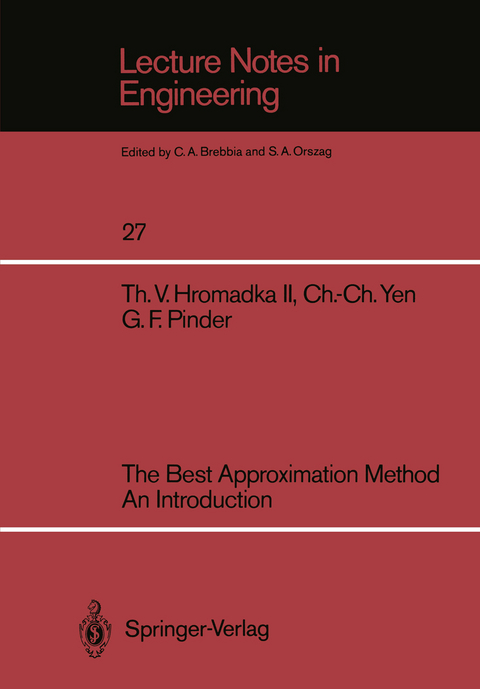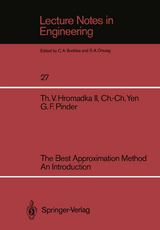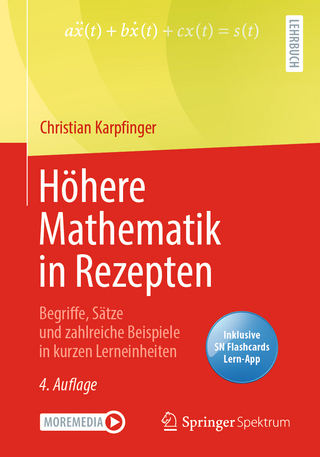The Best Approximation Method An Introduction
Springer Berlin (Verlag)
978-3-540-17572-8 (ISBN)
GEORGE F. PINDER, PhD, is a professor in the Civil and Environmental Engineering Department and a professor of mathematics and statistics at the University of Vermont in Burlington.
1. Work Spaces.- 1.1. Metric Spaces.- 1.2. Linear Spaces.- 1.3. Normed Linear Spaces.- 1.4. Banach Spaces.- 2. Integration Theory.- 2.0. Introduction.- 2.1. The Riemann and Lebesgue Integrals: Step and Simple Functions.- 2.2. Lebesque Measure.- 2.3. Measurable Functions.- 2.4. The Lebesgue Integral.- 2.5. Key Theorems in Integration Theory.- 2.6. Lp Spaces.- 2.7. The Metric Space, Lp.- 2.8. Convergence of Sequences.- 2.9. Capsulation.- 3: Hilbert Space and Generalized Fourier Series.- 3.0 Introduction.- 3.1. Inner Product and Hilbert Space (Finite Dimension Spaces).- 3.2. Infinite Dimension Spaces.- 3.3. Approximations in L2(E).- 3.4. Vector Space Representation for Approximations: An Application.- 4. Linear Operators.- 4.0. Introduction.- 4.1. The Derivative as a Linear Operator.- 4.2. Linear Operators.- 4.3. Examples of Linear Operators in Engineering.- 4.4. Linear Operator Norms.- 5. The Best Approximation Method.- 5.0. Introduction.- 5.1. An Inner Product for the Solution of Linear Operator Equations.- 5.2. Orthonormalization Process.- 5.3. Generalized Fourier Series.- 5.4. Approximation Error Evaluation.- 5.5. The Weighted Inner Product.- 6. The Best Approximation Method: Applications.- 6.0. Introduction.- 6.1. Sensitivity of Computational Results to Variation in the Inner Product Weighting Factor.- 6.2. Solving Two-Dimensional Potential Problems.- 6.3. Application to Other Linear Operators.- 6.4. Computer Program: Two-Dimensional Potential Problems Using Real Variable Basis Functions.- 7. Coupling the Best Approximation and Complex Variable Boundary Element Methods.- 7.0. Introduction.- 7.1. The Complex Variable Boundary Element Method.- 7.2. Mathematical Development.- 7.3. The CVBEM and W?.- 7.4. The Space W?A.- 7.5. Applications.- 7.6. Computer Program:Two-Dimensional Potential Problems Using Analytic Basis Functions (CVBEM).- References.- Appendix A: Derivation of CVBEM Approximation Function.- Appendix B: Convergence of CVBEM Approximator.
| Erscheint lt. Verlag | 31.3.1987 |
|---|---|
| Reihe/Serie | Lecture Notes in Engineering |
| Zusatzinfo | XIV, 172 p. |
| Verlagsort | Berlin |
| Sprache | englisch |
| Maße | 170 x 244 mm |
| Gewicht | 334 g |
| Themenwelt | Mathematik / Informatik ► Mathematik ► Algebra |
| Mathematik / Informatik ► Mathematik ► Angewandte Mathematik | |
| Technik | |
| Schlagworte | Finite Element Method • integral equation • Operator • operator theory |
| ISBN-10 | 3-540-17572-5 / 3540175725 |
| ISBN-13 | 978-3-540-17572-8 / 9783540175728 |
| Zustand | Neuware |
| Informationen gemäß Produktsicherheitsverordnung (GPSR) | |
| Haben Sie eine Frage zum Produkt? |
aus dem Bereich




